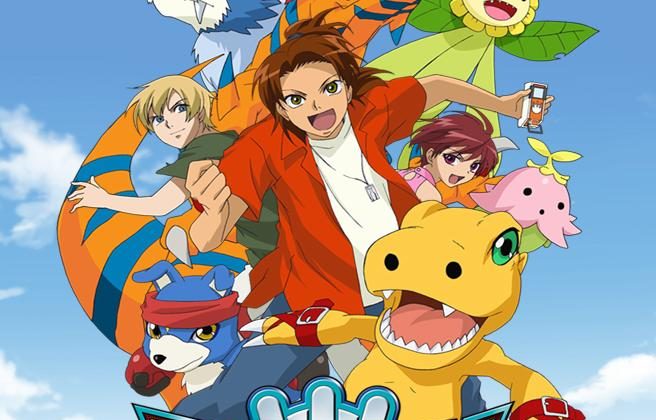Who else thinks that the 90’s was hands down the best time to grow up? Well, we certainly do—the 21st century does not even come close!
Without the temptation of smart devices, along with limited resources, we became masters of creativity to achieve a mutual goal—maximum entertainment with a minimum budget.advertisement

Just for old time’s sake, here is a list of our most popular childhood games and how to play them. Many are made from the most economical and affordable materials, modified to provide us with the highest level of amusement.
1. Eraser Battles

Source: Amulet Forums
True story—these erasers were never used for erasing.
Cheap and highly affordable, no 90’s childhood would be complete without a game of eraser battle. Each flag-printed eraser only cost us RM0.10, and we would save up our pennies to build our ever-expanding eraser army.
How to play—Eraser Stack Battle:
Use your thumbs or forefingers to take turns flipping your erasers until one lands on top of the other. The owner of the eraser on top is the winner, and gets to seize all other erasers in the game.

Source: Flickr
And let’s not forget the legendary spinning erasers. We would even have our very own ‘lucky erasers’ or use highlighters and ballpoint pens to fancy them up.
How to play—Eraser Spin Battle:
Staple multiple bullets onto the base of the eraser and spin it as hard as you can. The last eraser that remains spinning is then declared the winner.
Eraser battles can be played in groups of three or more, but for maximum intensity and entertainment, we strongly recommend that you play in pairs.
Here’s a live tip:
2. Rock, Paper, Scissors
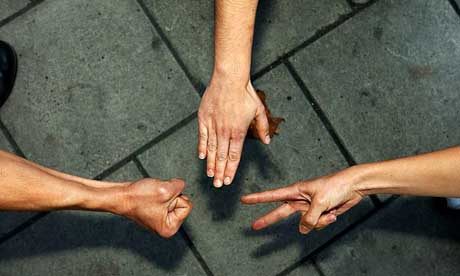
They have no erasers on hand. | Source: Tresixty
The proper name for this hand game is Rock, Paper, Scissors, but it is more commonly known here as “One, Two, Jus” or “One, Two, Som”. Commonly used as a decision-making method similar to flipping a coin, everyone from the 90’s should be familiar with this basic game.
How to play:
With one hand behind your back, curl it up into a fist and shake it thrice while chanting “One, Two, Jus”. On the last syllable, bring out your hand and form one of the three gestures involved in the game. (Ref. image above.)
– Rock (a closed fist)
– Paper (a flat hand)
– Scissors (a closed fist with index and middle finger extended)
Rock destroys scissors, scissors cut paper and paper covers rock. If the same gestures are formed, it is a draw.
Other than a kiasu decision-making method, One, Two, Jus also comes with punishment variants to add an extra thrill.
Having the back of the hand slapped to an angry red? Check.
Widening the gap between two legs until splitting point? Also check.

It’s only a matter of time he goes nuts. | Source: The STAR
3. Pepsi-Cola
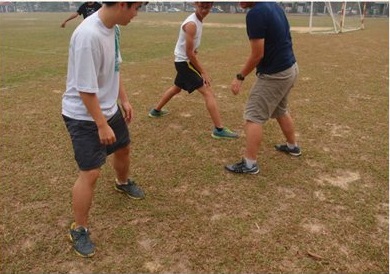
Source: MOB
Popular especially during rehat sessions in primary school, this game was one of my favourites as it gave me an excuse to jump around after hours of being cooped up in stuffy classrooms and laboratories.advertisement

How to play:
All players stand in an outstretched circle and point to each one of the players while chanting “Pepsi Cola*, buatan Malaysia, tak laku dijual di India. Satu, dua, tiga, empat, lima, enam, tujuh, lapan, sembilan, sepuluh!” (Editor’s Note: I cannot vouch for the validity of this chant. Our childhoods are clearly unique.) to determine who will start the game. The person whom the finger lands on then starts the game.
The starter (Player A) then has to stamp on or swipe at the foot of the player to their left (Player B). Player A is only allowed to aim for the area below the knee. Only if Player B is located far away Player A is allowed to take one or two extra steps.
If Player A successfully swipes at Player B, then Player B is then ‘dead’ and Player A goes on to ‘attack’ player C, etc. (ref. video below)
The objective of the game is to eliminate as many people as possible.
Also, there was something satisfying about seeing those snow-white school shoes turn grey. We can’t say that our mums were pleased with the end results of this game!
Requiring minimal props and space, Pepsi-Cola is still played extensively by local communities.
4. Wei Qi
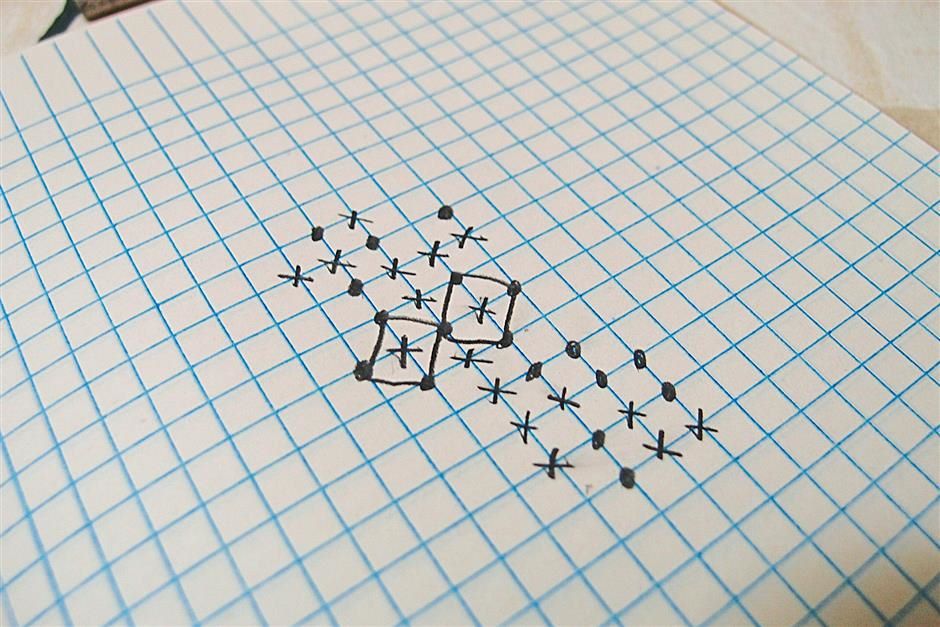
Source: The STAR
Played on the pages of maths exercise books, this is a simplified version of the game ‘Go’ that originated from China.
How to play:
Each player chooses his or her own unique symbol then take turns making a mark on the intersection points between the lines on the paper. The objective of the game is simple—to ‘encircle’ (as the literal translation of the Chinese name suggests) as many of the opponent’s dots as you can. The symbols can be connected in a straight line or diagonally across.
This strategy game requires a high level of concentration, and our fondest memory of this game was playing while the teacher was teaching giving us free time to do our work, passing it to and fro under our desks.
5. Paper Fortune Tellers/Mulut Itik
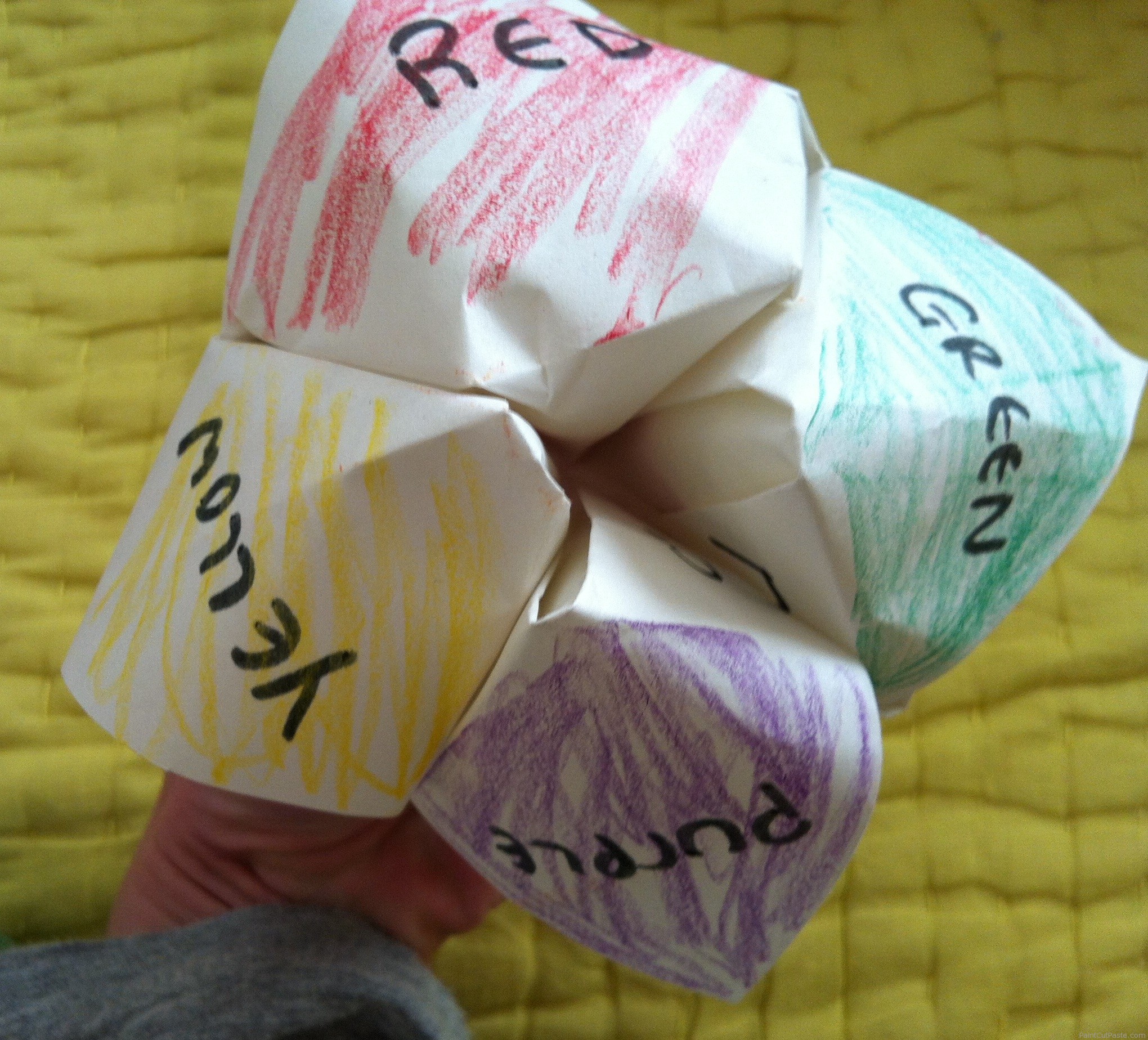
Source: Paint Cut Paste
These paper fortune tellers originated from England and they have claimed a huge part of our childhood. We would spend ages decorating our paper fortune tellers, thinking up ridiculous fortunes like “you will marry your best friend” and “you will get a beating tomorrow”. The fortunes never got old and we had hours of fun, with just one piece of paper!
How to play:
Click here to learn how to fold your own paper fortune teller and write your fortunes on the inside flaps.
Then, check out the video below on how to use it:
6. Batu Seremban

Source: Traditional Games in Malaysia
Who knew that our modest five stones game used to be played with sheep’s knucklebones during the Trojan war? Fast forward 3800 years, and knucklebones (a.k.a. Fivestones) have now evolved into the batu seremban that we all know and love.
Traditionally played by girls, this game was the epitome of childhood for many. The ‘stones’ are actually little cloth sacks of green beans, rice or saga seeds sewn into the shape of a pyramid.
How to play:
There are multiple levels to this game, all requiring increasing levels of dexterity and accuracy.
And because words might not do the gracefulness of this game justice, here’s a video for guidance (P.S. it’s harder than it looks!):
Some of my fondest primary school memories include sitting on the dusty granite floor in my dark blue pinafore, trying my very best to throw the stones in such a way that they would not land on my face.
Do not be fooled by their size—these little guys can pack quite a punch!
Also, did we mention that the best part of this game is making and customizing your own stones?

Source: Hilman Hakim

Source: The Funky Logic of C++
Cute as buttons, they make great gifts too! Our favourites are the ones wrapped in batik.
What’s yours?
7. Masak-masak

Source: Toddler can read
Masak-masak literally translates as ‘cooking’, and was the 90’s version of The Sims—even before Barbie Dolls existed. At a tender age, role-playing ‘family’ or ‘house’ was particularly appealing to us because it allowed us to break boundaries and be whomever we wanted to be, as well as creating the ideal family life.
Mini plastic cutlery sets, pots and pans, or even plastic fruits and vegetables were sold in local sundry shops for this purpose, but most of the time we would just take ingredients and equipment from our kitchen at home.
How to play:
Pretend you’re a hawker shop owner, a princess or even a fairy—cooking a meal for your family and friends. Conjure up stories, live out fantasies that you’ve always wanted to live—nothing is too big or too ridiculous!
There is no specific way to play this game. Anything is possible, so let your imagination run wild.
My favourite memory of playing masak-masak is following my mother to the local wet market and coming home with bits and pieces of vegetables that the shop owner graciously bestowed upon me. I would then proceed to chop up these vegetables and whip up ‘meals’ for my ‘family’.
Not the most glamorous part of my childhood, I would say, but definitely one of the most memorable ones.
8. Card Games

Source: Patrick Pang
90’s kids will remember the shock of having “snap!” yelled at the most unexpected moments. Although based on very simple concepts, these recycled-paper-printed cards provided loads of fun.
Four of the most common card games include Donkey, Happy Family, Old Maid and Snap.
How to play:
Out of the four games, my favourite was definitely Snap due to the high level of suspense. At that stage in life, the satisfaction of sweeping away a towering pile of cards, when everyone else was in a state of confusion, was the best feeling in the world!
9. Board Games

Source: HelloKitty Karma

Source: HelloKitty Karma
Forget fancy-schmancy games like Monopoly and Scrabble—we grew up with board games like Snakes and Ladders and Aeroplane Chess. Bet you non-90’s kids have never heard of them!
Unlike the modern board games made of solid plastic or high-quality waterproof cardboard, the board games back in our days were merely pieces of high density lightweight polyethene (in other words, plastic bag material) printed with various game layouts.
How to play:
These were favourites to play in class during Teacher’s Day or Children’s Day when the teachers were tied up and we we were supposed to be studying given a break.
10. Uno Stacko

Source: DeviantART
Jenga might be all the rage now, but back it the days, it was Uno Stacko that really stole the limelight.
A mix of Uno and Jenga, this game seems simple, but just like a game of chess, it actually requires tactic. The version that we are familiar with comes with an ‘Uno Cube’ dice, whereas in later versions, the dice is eliminated.
How to play:
Colored plastic blocks numbered one to four are stacked accordingly, and players roll the dice to determine their moves. The player then pulls out a block having the same number or color as indicated on the dice. The block is then put on top of the tower and the game continues until the tower topples over.
Later versions also include ‘Draw Two’, ‘Skip’, ‘Reverse’ and other named blocks as per the Uno card game.
Stocked up by our school libraries, this stacking game was one way we passed time during those boring post-UPSR/-PMR/-SPM days when we were forced still required to show up at school even though no classes were held.
Check out this badass tower trick:
11. Tamagotchi

Source: Wikipedia
Back in those days, we all wanted pets. Especially pets that did not require braving the smell of excretion to clean up after, did not need hours of grooming, yet were adorable and amusing enough to help us unwind after an exhausting day at school and tuition classes.
So, imagine our ecstasy when the Tamagotchi was introduced in 1996!
The name ‘Tamagotchi’ is a combination of the Japanese word ‘tamago’ which means egg, and ‘gotchi’ which means watch. Originally targeted at young girls to teach them how to be a mother, the Tamagotchi became an instant hit in Malaysia, not only among the girls, but boys as well!
How to play:
The story behind the game is simple—an alien egg is dropped onto Earth, and it is up to the player to raise it into an adult. Just like a normal pet, the player has to feed it, play with it and clean up after it, but all with a press of a button!
The appeal of this game mostly lies in the fact that the actions of a player—how well the pet is looked after, how many times it is played with—will determine the ‘status’ of the pet in terms of happiness and health. In fact, a Tamagotchi can actually ‘die’ if it is neglected for too long.
Fun Fact: Tamagotchis can also get married and produce offspring. We used to bring our little pocket-pets to tuition classes to ‘matchmake’ them with our friend’s little creatures via infrared!

Source: Tamagotchi.de
12. Mario Teaches Typing

Source: Reddit
If you don’t remember Mario Teaches Typing, the computer classes in primary school have definitely gone to waste!
By providing young players with a familiar interface, this game aims to teach keyboard typing to children, as its name straightforwardly suggests.
How to play:
The game display shows two hands. When an alphabet approaches, a certain finger will be highlighted. If the wrong alphabet is typed, the character will not advance until the correct one is typed.
Come to think of it, this game was actually the highlight of our primary school days, for we only got to escape the sweltering heat when we went to the computer lab!
13. Gameboys
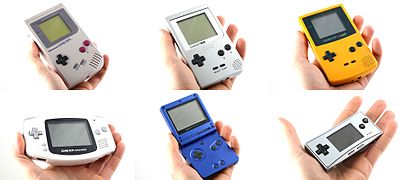
Source: Wikipedia
And to top it all off—Gameboys. How could we ever forget them? Before Xbox-es, Play Stations and Wiis even existed, we had the Nitendo Gameboy, Gameboy Color and Gameboy Advance. Launched in 1989, the Gameboy was a revolution in video-gaming. We were absolutely fascinated by how a single cartridge could contain our favourite games, enabling us to play anywhere and everywhere.
Of course, the Gameboy was hefty on our budgets, and not all of us could afford them. It was not an uncommon sight to see large groups of children gathered around a single Gameboy, cheering for their favourite game character.
Two of the most popular Nitendo games were Pokémon and Digimon:
Pokémon:

Source: Urban Times
Not only did we love the video game, but we also worshipped all other things Pokémon–the cards, the show and the merchandise! Gotta catch ‘em all!
Originally named “Pocket Monsters”, the Pokémon franchise is based on creator Satoshi Tajiris childhood pastime of collecting insects. There are two main goals in the game—to capture all the Pokémon in the Pokedex (the Pokémon bible), and to train strong team of Pokémon, conquering all other teams and eventually becoming the Pokémon master.
Each fictional Pokémon possesses special abilities based on the five elements—fire, earth, wind, water and ground—which are further enhanced when they evolve. These creatures live in the wild, and it is the player’s job to catch and train them to create an army.
There are 24 versions of the video game and 719 Pokémons as of now, but our favourites are still the original versions—Red, Green, Yellow and Blue. Besides, who can ever resist electric-shocking Pikachu, water-shooting Squirtle, fire-breathing Charmander and vine-snapping Bulbasaur, four of the most iconic and adorable Pokémon from the original 151 Pokémon?

Source: Tumblr
Digimon:
Source: Wikipedia
Pokémon fans will tell you that Digimon (also known as Digital Monsters) does not even come close to Pokémon, but we think otherwise!
Although also based on the concept of fictional creatures with special abilities, Digimon was first created as a virtual pet and was largely influenced by Tamagotchi. It only evolved into a video game later on, which became an instant hit with the kids public.
In the video game, Digimons are hatched from eggs and raised by ‘Tamers’ to restore peace in the world. Unlike Pokemon, Digimon are able to converse in human language.
Digimon Then
Digimon Then VS. Now Then
Some of the most popular Digimons from our time were Agumon (fire-breather), Betamon (water-tower) and the absolutely adorable Chibimon (headbutt-er).
Which ones were your favourites?
Our stand stays strong—nothing beats growing up in the 90’s.
Which retro games do you think should make a comeback? Let us know in the comments below!
Also, check out these awesome snacks and cartoons ’90s kids will definitely want to buy/torrent after reading recognize.
